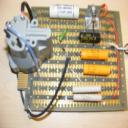Yahoo Answers is shutting down on May 4th, 2021 (Eastern Time) and the Yahoo Answers website is now in read-only mode. There will be no changes to other Yahoo properties or services, or your Yahoo account. You can find more information about the Yahoo Answers shutdown and how to download your data on this help page.
over charging a battery,how can it be possible,when a battery reaches?
voltage of the charging voltage,there can't be any flow of current in either direction.
11 Answers
- ?Lv 62 years ago
As long as there’s acid inside the battery Will Produce electricity .Which mean when is reach require charge it will go over and will start to boiling, even will explode the battery.
- ?Lv 72 years ago
The chemistry of a battery creates a limited voltage, depending on the state of charge. If the charging voltage is higher than the charged voltage that the battery is capable of then the charge current begins destroying the battery. The battery can not oppose a voltage higher than that which the chemistry produces.
- PhilomelLv 72 years ago
A charger is set to a voltage higher than the fully charged level of the battery by an amount which will not produce an overcharge. This level is selected by knowing the internal resistance of the battery when it is fully charged. The manufacturer has a table which will show the best charge Voltage for a constant voltage charger and best current for a constant current charger.
When the battery is fully charged there will be a very low trickle charge current in the system which will hold the full voltage and not be excessive to produce overcharge.
- ?Lv 62 years ago
Nobody has given a completely satisfactory answer. Mr Un-couth has nicely explained why the charger voltage has to be greater than the battery potential. This is significant.
I was once given a vague explanation, the truth of which I have never properly investigated. I post it here in the hope that someone else can explain or verify it.
The potential of the charger drops when it is connected to the battery, and charging begins the electrolysis which returns the battery to the charged state.
As the charging progresses,the resistance of the battery increases as it accepts the charge, and the charger voltage rises as the load resistance increases.
When the battery is fully charged, the charger voltage is greater than the battery's potential, and if the battery is not disconnected at this point there is a chance that further electrolysis can occur which will build up a passive oxide layer on the battery's plates, which impedes the battery's performance - that is the overcharged state. You might expect that an electronically controlled charger should stop charging before it gets that far, but I don't think many are actually that sophisticated.
Back in time you could buy tablets which somehow remedied vehicle batteries that were overcharged - one tablet per cell - but with these modern sealed batteries being fashionable you do not see those tablets any more.
- Mr. Un-couthLv 72 years ago
In order to charge a battery, that is to force current from positive terminal to the negative terminal of the battery internally the output Voltage of the charger must be greater than the emf of the battery plus the Voltage drop across the internal resistance of the battery. Every operational battery has a finite internal resistance whose value within it's range of resistance values depends on the instantaneous charge that exist on the battery at the present time. The greater the charge that exist on a battery the lower the internal resistance will be within the internal resistance range of a given battery. As a battery is being charged it's internal resistance is being lowered until it reaches it's lower limit.
The emf of any battery is fixed. When the internal resistance of the battery has reached it's lower extreme due to being charged, and the output Voltage of the charger is greater than the [(battery emf) + (voltage drop across the internal resistance of battery)] then the battery is being overcharged. What this boils down to when overcharging a battery is attempting to lower the internal resistance of the battery lower than the minimum extreme of the range of the internal resistance of the battery. The range of the internal resistance of the battery along with the value of it's emf is determined during the process of being built and can not be altered by the user after leaving the factory.
- LGLv 72 years ago
I think with some battery chemistries there isn't much voltage difference between fully charged and over charged. So if the voltage isn't tightly controlled or the amount of charge going into the battery(current times time) isn't monitored can be easy to go over.
The fully charged voltage can also shift a bit as the battery ages. So if the charger doesn't keep track of this, it can also lead to overcharging.
- 異域秦後人Lv 72 years ago
It only happens to some cheap made charger or old day charger that common feeds higher voltage to battery under charge. As battery is fully but charger still forces current into it, battery becomes hot and burning away its inside chemical liquid. Battery becomes dry or even short after over charge has been taken a long time.
It would not happen with a smart charger that automatically cut off power while battery is fully charger.
- don_sv_azLv 72 years ago
The charging voltage is higher than the rated voltage of the battery.
A 12 volt battery charges at 13.2-14.7 volts. Some solar systems charge at 17+ volts.
A 1.5 volt battery charges at 1.6-1.9 volts.
If you leave the battery n that high voltage for long periods of time after it is fully charged it may damage the battery.
- billrussell42Lv 72 years ago
yes, but the charging voltage is usually higher than the battery voltage, it has to be to ensure current over a range of temperature and line voltage.
In other words, the charger has to work over a range of line voltages. That means at high line the voltage is much higher than needed. Plus, the battery voltage varies with temperature and the charger has to have a higher voltage to cover that possibility.






